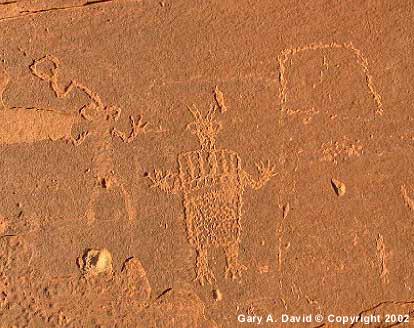 |
| Ancestral
Hopi petroglyph located in northern Arizona |
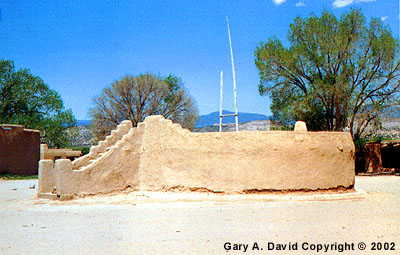 |
| Kiva
at San Ildefonso Pueblo,
New Mexico Ancient Hopi kivas were round like this but later became rectangular. |
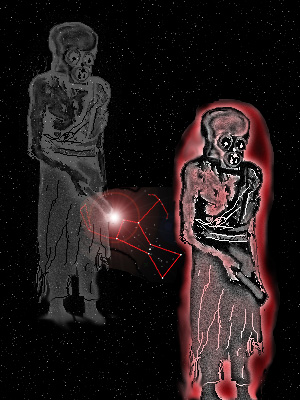 |
| Figure
adapted from an illustration by Petra Roeckerath, Stories of Maasaw, A Hopi
God, Ekkehart Malotki and Michael Lomatuway'ma, University of Nebraska Press, Lincoln, 1987 |
The Hopi god of death, the earth, and the Underworld is named Masau’u.
Like the ants, he possess knowledge of both the surface of the earth and the chthonic
regions. He wears a mask with large open eye holes and a large mouth. His huge,
bald head resembles a summer squash, and his forehead bulges out in a ridge. His
feet are long as a forearm, and his body is gray. This color is essential, since
his name comes from the Hopi word maasi, meaning gray. In fact, this description
from Hopi mythology is uncomfortably close to contemporary images of extraterrestrial
Greys.
Masau’u is also the terrestrial equivalent of Orion, whose name, as we said, means
ant. The Hopi believe that distances are insignificant to Masau’u because he can
traverse the entire earth before morning comes. What better way to express Orion’s
movement from the eastern to the western horizon during the night?
The
Hopi word for ant is anu. In the same language naki means friend,
prayer feathers, food offerings, or sand-- a nexus of concepts pertaining to this
insect that sometimes flies. A combination of the two words (anu-naki,
or “ant friend”) may be related to Sitchin’s Anunnaki. The Babylonian sky god
was also named Anu. One Sumerian cylinder seal from around 2250 B.C. shows the
pantheon of primary deities wearing peaked hats. The Hopi sky god Sotuknang, closely
associated with the earth god Masau’u, also wears a pointed headdress. Like their
Middle Eastern counterparts, these American Indian divinities were present at
the creation of the universe and continued to be instrumental in the culture’s
development.
Anu (or Danu) was also the appellation of the Celtic mother
goddess and patroness of the dead. In addition, Anu was another name for the Egyptian
city of Heliopolis, where the benben stone of meteoric iron was kept.
Furthermore, the Egyptian word anu meant not only products, revenues, or
something brought in but also gifts, tributes, and offerings. This refers to both
the ants’ ability to store provisions and the reverence given to the Ant People.
In any case, their influence is global.
Mythological
Evidence
Ants played a crucial role in the survival of the
ancient Hopi. The Ant People’s great kiva provided sanctuary during both the destruction
of the First World, or First Era, by fire (volcanism or asteroids) and the Second
World by ice (glaciers). [For a possible location of this, see Jack Andrews’ web
site “Lost City of
the Dead in the Grand Canyon.”] Only the virtuous members of the tribe following
a certain cloud by day and a certain star by night were able to find the sky god
Sotuknang. He elected to save these migrating “chosen people” by leading them
to the Ant People for protection.
Ants are portrayed as generous and
industrious, offering the Hopi sustenance when supplies ran short and teaching
them the merits of food storage. In fact, ants have such thin waists today, the
legend goes, because they once deprived themselves of provisions. In another account
of the earliest eras, the Hopi themselves are described as ants when they were
“way underneath.” The word underneath refers to both the Ant Kiva and the subterranean
First and Second Worlds. The previous Third World destroyed by a flood is also
conceptualized as being below ground, whereas our present Fourth World is on the
Earth’s surface.
According to a rather brutal Hopi myth of “Why the Ants
Are So Thin,” many ants were living east of Toko’navi, or Navaho Mountain near
the Arizona/Utah border. These insects are described not in the allegorical manner
of an Aesop fable but in an almost humanoid way. During a Kachina Society initiation,
two ants had dressed up as fierce, giant Hu kachinas and flogged the ant children
so hard that they were almost cut through in the middle of their bodies, hence
their slenderness. Is this another reference to “giants in the earth”?
Ants are also associated with either warfare or hunting. The Hopi believe that
both traits are related to Orion in particular and stars in general. This tribe
also connects black ants with witchcraft. The Hopi word Toko’anu (similar
to the mountain’s name) literally means flesh ant, the large dark red ant with
a painful sting. On the other hand, the Red Ant Society of the Zuni, a tribe that
lives near the Hopi, is associated with healing.
In Mesoamerica the
Maya, who share many cultural traits with the Hopi, tell legends of ant-like men
building stone cities and roads during the First Creation (World). These peculiar
beings possessed magical powers and could summon stones into proper architectural
positions by just whistling.
Archaeologist J. Eric S. Thompson writes:
“Zayamuincob can be translated as ‘the twisted men’ or ‘the disjointed
men,’ suggesting a connection with ‘hunchback.’ The word may also be connected
with zay, ‘ant,’ for there is also a Yucatec [Yucatan Maya] tradition of
an ancient race called chac zay uincob, ‘red ant men.’ They were industrious
like the ants which take out the red earth and make straight roads through the
forest.”
The reference to hunchback reminds us of Koko Pilau (Kokopelli),
the humpback flute player. This is the ubiquitous, insect-like fertility figure
of Southwest petroglyphs.
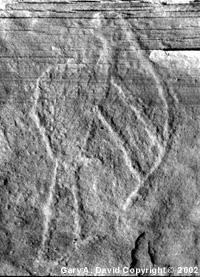 |
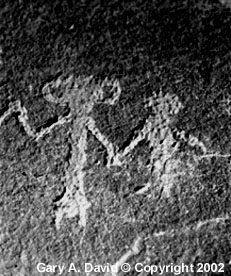 |
| Petroglyph
at Cottonwood Creek Ruin near Homolovi State Park, Arizona |